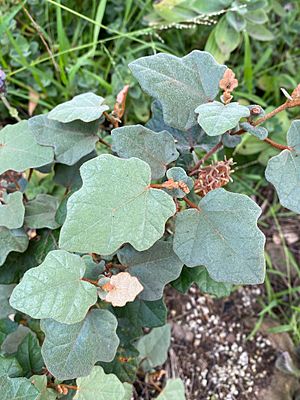Thomasia triphylla facts for kids
Quick facts for kids Thomasia triphylla |
|
|---|---|
 |
|
| Scientific classification | |
| Genus: |
Thomasia
|
| Species: |
triphylla
|
Thomasia triphylla is a small, pretty shrub. It grows only in the south-west part of Western Australia. Its flowers are pinkish-purple and shaped like bells. They hang down from where the leaves meet the stem.
What Does Thomasia triphylla Look Like?
Thomasia triphylla is a small bush with many stems. It can grow to be about 0.3 to 1.2 meters (about 1 to 4 feet) tall. Its stems feel a bit hairy.
The leaves are about 25 to 60 millimeters (1 to 2.5 inches) long. They are also about 10 to 35 millimeters (0.4 to 1.4 inches) wide. The edges of the leaves have deep, uneven cuts. The surface of the leaves is covered in tiny hairs that look like stars.
At the bottom of the leaves, there are two small leaf-like parts called stipules. These stipules fall off as the plant gets older. They are about 10 to 15 millimeters (0.4 to 0.6 inches) long. You can only see them on the younger leaves.
The plant's flowers have parts called sepals. These sepals can be purple, pink, or white and feel smooth. Each flower has five free stamens, which are the parts that make pollen. The thin stalks of the stamens are about 4 millimeters long. This plant can bloom in July, August, or during spring.
How Did It Get Its Name?
The plant Thomasia triphylla was first officially described in 1821. A scientist named Jacques Etienne Gay wrote about it. His description was published in a book called Memoires du Museum d'Histoire Naturelle.
The second part of its scientific name, triphylla, tells us something special. It means "three leaves." This refers to the two large, leaf-like stipules at the base of the leaf stalk. They look like extra leaves!
Where Does It Grow?
This plant likes to grow in sandy areas and places with limestone. You can find it along the coast in the south-west of Western Australia. It grows in several spots from Albany all the way to Esperance.


